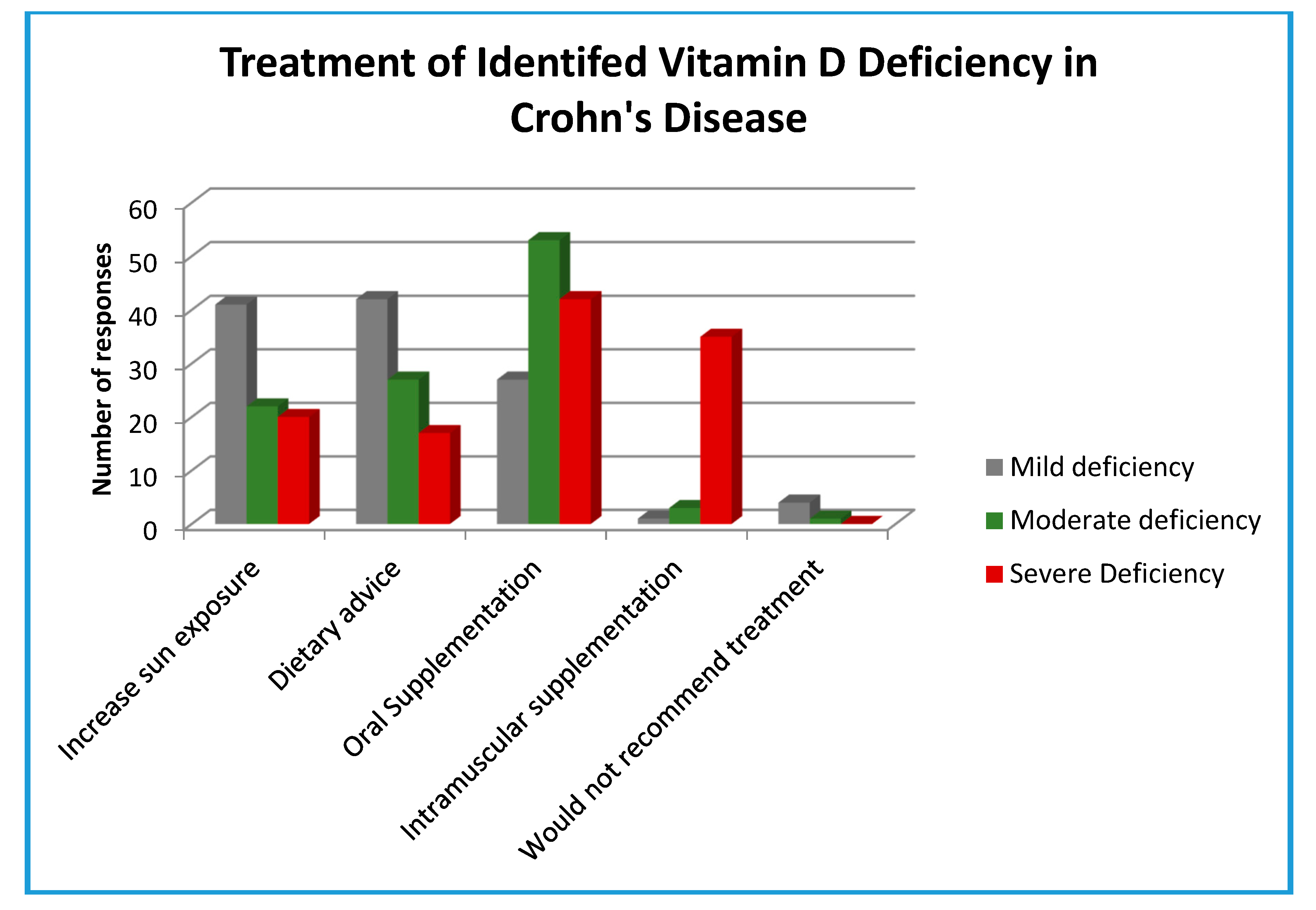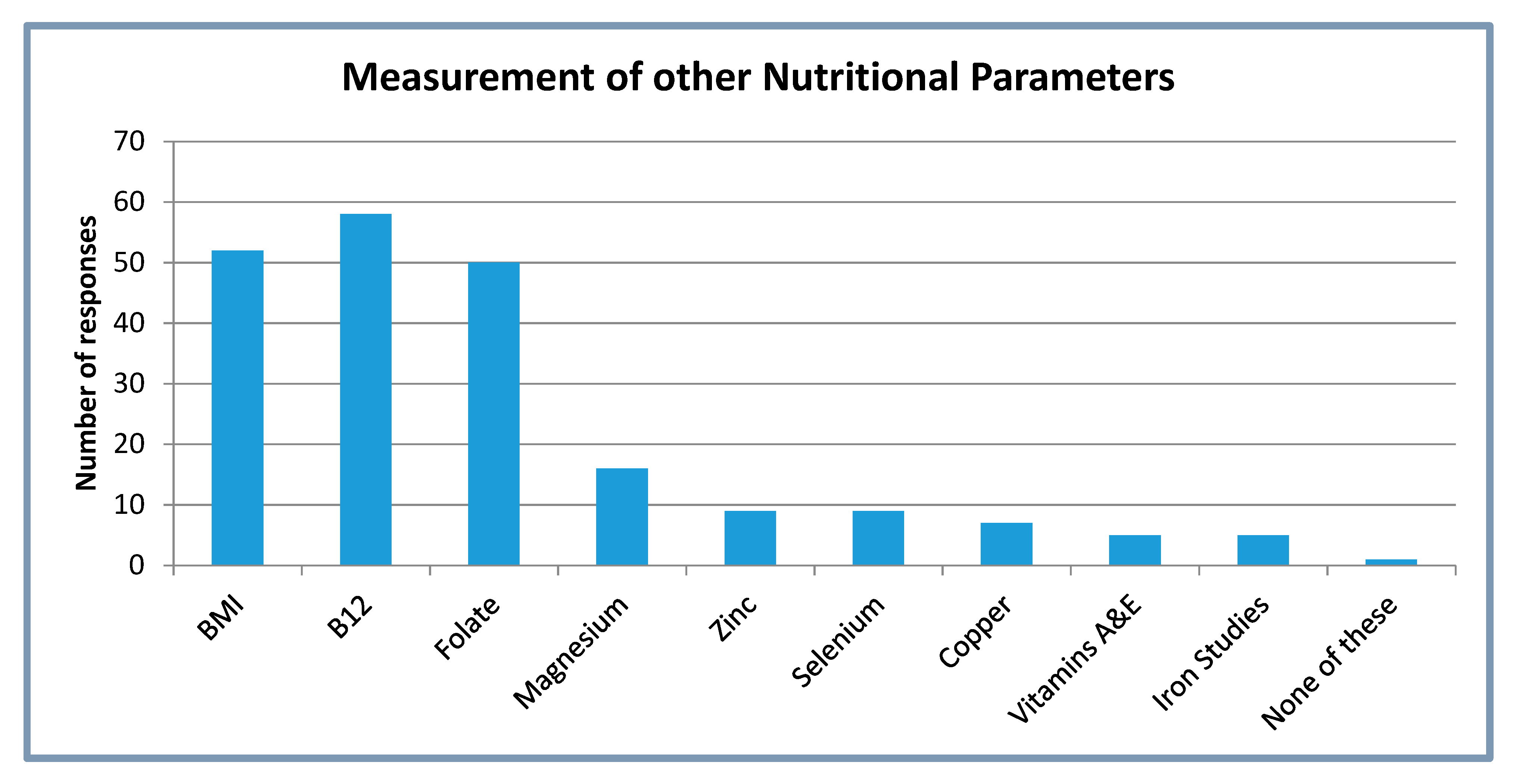Screening and Treatment of Vitamin D Deficiency in UK Patients with Crohn’s Disease: Self-Reported Practice among Gastroenterologists
Abstract
1. Introduction
2. Materials and Methods
2.1. Survey Distribution
2.2. Survey Design
2.3. Ethical Considerations—Consent
2.4. Statistical Analysis
3. Results
3.1. Demographic Data of Respondents
3.2. Vitamin D Screening in Practice
3.3. Season, Ethnicity and Other Factors
3.4. Awareness of Guidelines
3.5. Influences on Practice
3.6. Other Nutritional Monitorin
3.7. Bone Health
4. Discussion
4.1. Survey Design
4.2. Limitations
5. Conclusions
Supplementary Materials
Author Contributions
Funding
Acknowledgments
Conflicts of Interest
References
- Fletcher, J.; Cooper, S.C.; Ghosh, S.; Hewison, M. The Role of Vitamin D in Inflammatory Bowel Disease: Mechanism to Management. Nutrients 2019, 11, 1019. [Google Scholar] [CrossRef] [PubMed]
- Kabbani, T.A.; Koutroubakis, I.E.; Schoen, R.E.; Romos-Rivers, C.; Shah, N.; Swoger, J.; Regueiro, M.; Barrie, A.; Schwartz, M.; Hashash, J.G.; et al. Association of Vitamin D Level With Clinical Status in Inflammatory Bowel Disease: A 5-Year Longitudinal Study. Am. J. Gastroenterol. 2016, 111, 712–719. [Google Scholar] [CrossRef] [PubMed]
- Caviezel, D.; Maissen, S.; Niess, J.H.; Kiss, C. High Prevalence of Vitamin D Deficiency among Patients with Inflammatory Bowel Disease. Inflamm. Intest. Dis. 2018, 2, 200–210. [Google Scholar] [CrossRef] [PubMed]
- Frigstad, S.O.; Høivik, M.; Jahnsen, J.; Dahl, S.R.; Cvancarova, M.; Grimstad, T.; Berset, I.P.; Huppertz-Hauss, G.; Hovde, Ø.; Torp, R.; et al. Vitamin D deficiency in inflammatory bowel disease: prevalence and predictors in a Norwegian outpatient population. Scand. J. Gastroenterol. 2017, 52, 100–106. [Google Scholar] [CrossRef]
- Fletcher, J.; Swift, A. Vitamin D screening in patients with inflammatory bowel disease. Gastrointest. Nurs. 2017, 15, 16–23. [Google Scholar] [CrossRef]
- Lu, C.; Yang, J.; Yu, W.; Li, D.; Xiang, Z.; Lin, Y.; Yu, C. Association between 25(OH)D Level, Ultraviolet Exposure, Geographical Location, and Inflammatory Bowel Disease Activity: A Systematic Review and Meta-Analysis. PLoS ONE 2015, 10, e0132036. [Google Scholar] [CrossRef]
- Winter, R.W.; Collins, E.; Cao, B.; Carrellas, M.; Crowell, M.; Korzenik, J.R. Higher 25-hydroxyvitamin D levels are associated with greater odds of remission with anti-tumour necrosis factor-α medications among patients with inflammatory bowel diseases. Aliment. Pharmacol. Ther. 2017, 45, 653–659. [Google Scholar] [CrossRef]
- Ananthakrishnan, A.N.; Cagan, A.; Gainer, V.S.; Cai, T.; Cheng, S.C.; Savova, G.; Chen, P.; Szolovits, P.; Xia, Z.; De Jager, P.L.; et al. Normalization of plasma 25-hydroxy vitamin D is associated with reduced risk of surgery in Crohn’s disease. Inflamm. Bowel. Dis. 2013, 19, 1921–1927. [Google Scholar] [CrossRef]
- Ham, N.S.; Hwang, S.W.; Oh, E.H.; Kim, J.S.; Lee, H.-S.; Park, S.H.; Yang, D.H.; Ye, D.B.; Byeon, J.-S.; Myung, S.-J.; et al. Influence of Severe Vitamin D Deficiency on the Clinical Course of Inflammatory Bowel Disease. Dig. Dis. Sci. 2020, 1–10. [Google Scholar] [CrossRef]
- NICE. Crohn’s Disease Management: Clinical Guideline 152; National Institute for Health and Care Excellence (NICE), Ed.; Blackwell Publishing Ltd.: London, UK, 2012. [Google Scholar]
- NICE. Crohn’s Disease: management (NG129); National Institute for Health and Care Excellence, Ed.; NICE accredited: London, UK, 2019. [Google Scholar]
- Lewis, N.R.; Scott, B. Guidelines for osteoporosis in inflammatory bowel disease and coeliac disease. Br. Soc. Gastroenterol. 2007, 14, 1–16. [Google Scholar]
- Harbord, M.; Annese, V.; Vavricka, S.R.; Allez, M.; Barreiro-de Acosta, M.; Boberg, K.M.; Burisch, J.; De Vos, M.; De Vries, A.M.; Dick, A.D.; et al. The First European Evidence-based Consensus on Extra-intestinal Manifestations in Inflammatory Bowel Disease. J. Crohn’s Colitis 2015, 10, 239–254. [Google Scholar] [CrossRef] [PubMed]
- American Gastroenterological Association (AGA). American Gastroenterological Association medical position statement: guidelines on osteoporosis in gastrointestinal diseases. Gastroenterology 2003, 124, 791–794. [Google Scholar]
- Higashi, T.; Shimada, K.; Toyo’oka, T. Advances in determination of vitamin D related compounds in biological samples using liquid chromatography–mass spectrometry: A review. J. Chromatogr. B 2010, 878, 1654–1661. [Google Scholar] [CrossRef] [PubMed]
- Harris, P.A.; Taylor, R.; Thielke, R.; Payne, J.; Gonzalez, N.; Conde, J.G. Research electronic data capture (REDCap)--a metadata-driven methodology and workflow process for providing translational research informatics support. J. Biomed. Inform. 2009, 42, 377–381. [Google Scholar] [CrossRef]
- von Elm, E.; Altman, D.G.; Egger, M.; Pocock, S.J.; Gøtzsche, P.C.; Vandenbroucke, J.P. STROBE Initiative The Strengthening the Reporting of Observational Studies in Epidemiology (STROBE) statement: guidelines for reporting observational studies. Lancet 2007, 370, 1453–1457. [Google Scholar] [CrossRef]
- Liu, M.; Cernat, A. Item-by-item Versus Matrix Questions: A Web Survey Experiment. Soc. Sci. Comput. Rev. 2016, 36, 690–706. [Google Scholar] [CrossRef]
- Nielsen, O.H.; Hansen, T.I.; Gubatan, J.M.; Jensen, K.B.; Rejnmark, L. Managing vitamin D deficiency in inflammatory bowel disease. Frontline Gastroenterol 2019, 10, 394–400. [Google Scholar] [CrossRef]
- Nielsen, O.H.; Rejnmark, L.; Moss, A.C. Role of Vitamin D in the Natural History of Inflammatory Bowel Disease. J. Crohns Colitis 2018, 12, 742–752. [Google Scholar] [CrossRef]
- Wagnon, J.H.; Leiman, D.A.; Ayers, G.D.; Schwartz, D.A. Survey of gastroenterologists’ awareness and implementation of AGA guidelines on osteoporosis in inflammatory bowel disease patients: are the guidelines being used and what are the barriers to their use? Inflamm. Bowel. Dis. 2009, 15, 1082–1089. [Google Scholar] [CrossRef]
- Cunningham, C.T.; Quan, H.; Hemmelgarn, B.; Noseworthy, T.; Beck, C.A.; Dixon, E.; Samuel, S.; Ghali, W.A.; Sykes, L.L.; Jetté, N. Exploring physician specialist response rates to web-based surveys. BMC Med. Res. Methodol. 2015, 15, 32. [Google Scholar] [CrossRef]
- Cook, C.; Heath, F.; Thompson, R.L. A Meta-Analysis of Response Rates in Web- or Internet-Based Surveys. Educ. Psychol. Meas. 2000, 60, 821–836. [Google Scholar] [CrossRef]
- Rolstad, S.; Adler, J.; Rydén, A. Response Burden and Questionnaire Length: Is Shorter Better? A Review and Meta-analysis. Value Health 2011, 14, 1101–1108. [Google Scholar] [CrossRef] [PubMed]
- Verma, A.M.; Chilton, A.P. National survey of UK endoscopists showing variation in diathermy practice for colonic polypectomy. Frontline Gastroenterology 2019, 10, 120. [Google Scholar] [CrossRef] [PubMed]
- Broekaert, I.J.; Jahnel, J.; Moes, N.; van der Doef, H.; Ernst, A.; Amil Dias, J.; Thomson, M.; Tzivinikos, C. Evaluation of a European-wide survey on paediatric endoscopy training. Frontline Gastroenterol. 2019, 10, 188. [Google Scholar] [CrossRef]
- Fan, W.; Yan, Z. Factors affecting response rates of the web survey: A systematic review. Comput. Hum. Behav. 2010, 26, 132–139. [Google Scholar] [CrossRef]
- Joint Royal Colleges of Physicians Training Board. Speciality Training Curriculum for Gastroenterology (with amendments); Joint Royal Colleges of Physicians Training Boards: London, UK, 2010. [Google Scholar]
- Dix, C.F.; Robinson, A.; Bauer, J.D.; Wright, O.R.L. Vitamin D: Australian dietitian’s knowledge and practices. Nutr. Diet. 2017, 74, 396–407. [Google Scholar] [CrossRef]
- Rejnmark, L.; Bisley, L.S.; Cashmen, K.D.; Eiríksdottir, G.; Gaksch, M.; Grübler, M.; Gudnason, V.; Lips, P.; Pilz, S.; Kiely, M. Non-skeletal health effects of vitamin D supplementation: A systematic review on findings from meta-analyses summarizing trial data. PLoS ONE 2017, 12, e0180512. [Google Scholar] [CrossRef]
- Martineau, A.R.; Jolliffe, D.A.; Hooper, R.L.; Greenberg, L.; Aloia, J.F.; Bergman, P.; Dubnov-Raz, G.; Esposito, S.; Ganmaa, D.; Ginde, A.A.; et al. Vitamin D supplementation to prevent acute respiratory tract infections: systematic review and meta-analysis of individual participant data. BMJ Clin. Res. 2017, 356, i6583. [Google Scholar] [CrossRef]
- McDonnell, S.L.; Baggerly, C.A.; French, C.B.; Baggerly, L.L.; Garland, C.F.; Gorham, E.D.; Hollis, B.W.; Trump, D.L.; Lappe, J.M. Breast cancer risk markedly lower with serum 25-hydroxyvitamin D concentrations ≥60 vs <20 ng/ml (150 vs 50 nmol/L): Pooled analysis of two randomized trials and a prospective cohort. PLoS ONE 2018, 13, e0199265. [Google Scholar]
- McDonnell, S.L.; Baggerly, C.; French, C.B.; Baggerly, L.L.; Garland, C.F.; Gorham, E.D.; Lappe, J.M.; Heaney, R.P. Serum 25-Hydroxyvitamin D Concentrations >/=40 ng/ml Are Associated with >65% Lower Cancer Risk: Pooled Analysis of Randomized Trial and Prospective Cohort Study. PLoS ONE 2016, 11, e0152441. [Google Scholar] [CrossRef]
- McDonnell, S.L.; Baggerly, K.A.; Baggerly, C.A.; Aliano, J.L.; French, C.B.; Baggerly, L.L.; Ebeling, M.D.; Rittenberg, C.S.; Goodier, C.G.; Mateus Niño, J.F.; et al. Maternal 25(OH)D concentrations >/=40 ng/mL associated with 60% lower preterm birth risk among general obstetrical patients at an urban medical center. PLoS ONE 2017, 12, e0180483. [Google Scholar] [CrossRef] [PubMed]
- Parizadeh, S.M.; Jafarzadeh-Esfehani, R.; Hassanian, S.M.; Mottaghi-Moghaddam, A.; Ghazaghi, A.; Ghandehari, M.; Alizade-Noghani, M.; Khazaei, M.; Ghayour-Mobarhan, M.; Ferns, G.A.; et al. Vitamin D in inflammatory bowel disease: From biology to clinical implications. Complementary Ther. Med. 2019, 47, 102189. [Google Scholar] [CrossRef] [PubMed]
- Heaney, R.P. Guidelines for optimizing design and analysis of clinical studies of nutrient effects. Nutr. Rev. 2014, 72, 48–54. [Google Scholar] [CrossRef] [PubMed]


| Demographic Data of Respondents | |
|---|---|
| Reported Profession | |
| Gastroenterology Consultants | n = 48 (77%) |
| Gastroenterology Registrars | n = 11 (18%) |
| Registered Nurses | n = 3 (5%) |
| Institution | |
| University Teaching Hospital | n = 36 (58%) |
| District General Hospital | n = 25 (40%) |
| Primary Care | n = 1 (2%) |
| Age Ranges (years) (Mean = 43 years, SD = 9 ± 75) | |
| 30–39 | n = 13 (21%) |
| 40–49 | n = 19 (31%) |
| 50–59 | n = 27 (43%) |
| 60+ | n = 3 (5%) |
| Sub-Type of Crohn’s Disease andTreatment |
Reported Frequency of Vitamin D Screening in Crohn’s Disease n = 64 | |||
|---|---|---|---|---|
| Annually % | 6 monthly % | 3 monthly % | Rarely/Never % | |
| Small bowel CD | 55 | 26 | 5 | 12 |
| Crohn’s colitis | 53 | 16 | 3 | 28 |
| Peri-anal CD | 41 | 16 | 3 | 41 |
| Immuno-modulators | 48 | 29 | 3 | 21 |
| Biologic therapy | 48 | 28 | 2 | 22 |
| Steroids | 44 | 27 | 13 | 16 |
| History of surgery secondary to CD | 56 | 23 | 7 | 15 |
© 2020 by the authors. Licensee MDPI, Basel, Switzerland. This article is an open access article distributed under the terms and conditions of the Creative Commons Attribution (CC BY) license (http://creativecommons.org/licenses/by/4.0/).
Share and Cite
Fletcher, J.; Swift, A.; Hewison, M.; Cooper, S.C. Screening and Treatment of Vitamin D Deficiency in UK Patients with Crohn’s Disease: Self-Reported Practice among Gastroenterologists. Nutrients 2020, 12, 1064. https://doi.org/10.3390/nu12041064
Fletcher J, Swift A, Hewison M, Cooper SC. Screening and Treatment of Vitamin D Deficiency in UK Patients with Crohn’s Disease: Self-Reported Practice among Gastroenterologists. Nutrients. 2020; 12(4):1064. https://doi.org/10.3390/nu12041064
Chicago/Turabian StyleFletcher, Jane, Amelia Swift, Martin Hewison, and Sheldon C Cooper. 2020. "Screening and Treatment of Vitamin D Deficiency in UK Patients with Crohn’s Disease: Self-Reported Practice among Gastroenterologists" Nutrients 12, no. 4: 1064. https://doi.org/10.3390/nu12041064
APA StyleFletcher, J., Swift, A., Hewison, M., & Cooper, S. C. (2020). Screening and Treatment of Vitamin D Deficiency in UK Patients with Crohn’s Disease: Self-Reported Practice among Gastroenterologists. Nutrients, 12(4), 1064. https://doi.org/10.3390/nu12041064





